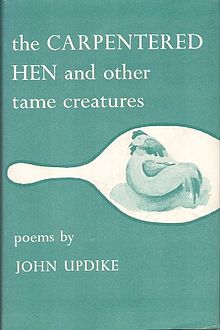 1932—John Hoyer Updike is born on 18 March in a hospital in West Reading, Pa., the only child of Linda Grace Hoyer Updike, an aspiring writer, and Wesley Russell Updike, a high school mathematics teacher. Because of hard times, they live with Linda’s parents at the house John Hoyer owned at 117 Philadelphia Avenue, in Shillington.
1932—John Hoyer Updike is born on 18 March in a hospital in West Reading, Pa., the only child of Linda Grace Hoyer Updike, an aspiring writer, and Wesley Russell Updike, a high school mathematics teacher. Because of hard times, they live with Linda’s parents at the house John Hoyer owned at 117 Philadelphia Avenue, in Shillington.
1936—Updike enters the Shillington public school system.
1943—Updike enters Shillington High School, where, as a seventh grader and with the publication of “A Handshake with the Congressman,” he contributes the first of some 285 drawings, articles, and light verse to the school newspaper and literary magazine, the Chatterbox.
 1945—Updike’s family moves from the house at 117 Philadelphia Avenue—which was within a short walk of the high school, the after-school hangouts, the playground, and the county poorhouse where children often played—to his mother’s birthplace on a 93-acre farm in nearby Plowville.
1945—Updike’s family moves from the house at 117 Philadelphia Avenue—which was within a short walk of the high school, the after-school hangouts, the playground, and the county poorhouse where children often played—to his mother’s birthplace on a 93-acre farm in nearby Plowville.
1950—Updike works as a copy boy for the Reading Eagle his first summer out of high school. In the fall he enters Harvard College on a tuition scholarship.
1951—Updike works at Willow, an unfinished and still unpublished first novel about Shillington.
1953—On 26 June he marries Radcliffe fine-arts major Mary Pennington, daughter of Rev. and Mrs. Leslie T. Pennington of Chicago, where Rev.
Pennington is minister of the First Unitarian Church.
1954—Updike graduates summa cum laude as an English major. That same year, The 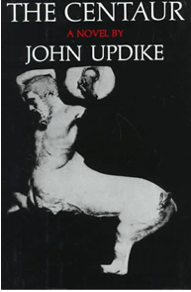 New Yorker buys one poem and one story: “Duet, with Muffled Brake Drums” (14 August issue) and “Friends from Philadelphia” (30 October issue). Updike attends the Ruskin School of drawing and Fine Art in Oxford, England, on a Knox Fellowship for the 1954-55 school year and meets Katherine White, who offers him a staff job at The New Yorker.
New Yorker buys one poem and one story: “Duet, with Muffled Brake Drums” (14 August issue) and “Friends from Philadelphia” (30 October issue). Updike attends the Ruskin School of drawing and Fine Art in Oxford, England, on a Knox Fellowship for the 1954-55 school year and meets Katherine White, who offers him a staff job at The New Yorker.
1955—Oldest daughter Elizabeth is born on 1 April. In August, the Updikes move to Manhattan, where he begins writing “Talk of the Town” columns for The New Yorker. Updike is also declared 4-F because of psoriasis.
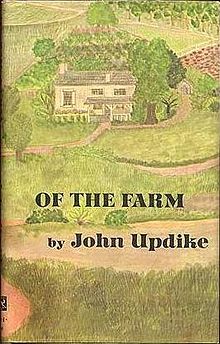 1957—Updike’s son David is born. Earlier, Updike completed Home, a 600-page rewrite of Willow, but decides to abandon the project. In March he quits his staff job at The New Yorker and relocates his family to Ipswich, Mass. (site of his honeymoon and model for the fictional Tarbox in Couples) to devote all of his time to writing. He works on a novel inspired by the poorhouse near his childhood home and the maternal grandfather he lived with.
1957—Updike’s son David is born. Earlier, Updike completed Home, a 600-page rewrite of Willow, but decides to abandon the project. In March he quits his staff job at The New Yorker and relocates his family to Ipswich, Mass. (site of his honeymoon and model for the fictional Tarbox in Couples) to devote all of his time to writing. He works on a novel inspired by the poorhouse near his childhood home and the maternal grandfather he lived with.
1958—Updike’s first book, The Carpentered Hen and Other Tame Creatures, a book of poems, is published by Harper and Brothers. Rather than change the ending of The Poorhouse Fair to accommodate his editors, Updike changes publishers. The Updikes move into  a 17th-century clapboard house at 26 East St. in Ipswich.
a 17th-century clapboard house at 26 East St. in Ipswich.
1959—Alred A. Knopf publishes his first short story collection, The Same Door, and his first novel, The Poorhouse Fair. Son Michael is born in May, and a grant from the John Simon Guggenheim Foundation enables Updike to work on Rabbit, Run, a longer novel based on his reaction to Jack Kerouac’s On the Road.
1960—Rabbit, Run is published, and The Poorhouse Fair receives the Rosenthal Award of the National Institute of Arts and Letters. In December, daughter Miranda is born.
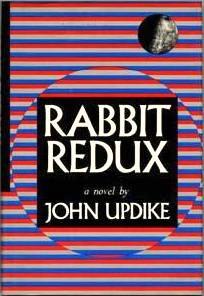 1963—Updike’s novel The Centaur is published, a tribute to his father, Wesley Updike.
1963—Updike’s novel The Centaur is published, a tribute to his father, Wesley Updike.
1964—Updike is elected a member of the National Institute of Arts and Letters and receives the National Book Award for Fiction for The Centaur. Updike travels to Russia, Bulgaria, Romania, and Czechoslovakia for the U.S. State Department.
1965—Updike is elected to the American Academy of Arts and Sciences.
1966—Updike receives the First O.Henry Prize for his short story, “The Bulgarian Poetess.”
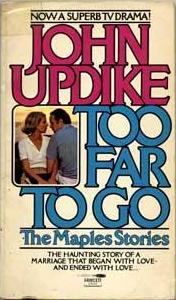 1968—Couples is published and becomes a scandalous best-seller. Updike is featured on the cover of the 26 April Time magazine, but Ipswich residents who see themselves in the novel prompt the Updikes to move to London for a year.
1968—Couples is published and becomes a scandalous best-seller. Updike is featured on the cover of the 26 April Time magazine, but Ipswich residents who see themselves in the novel prompt the Updikes to move to London for a year.
1970—Updike’s Jewish alter-ego emerges in Bech: A Book, while Rabbit, Run is made into a movie. Updike travels to Japan and Korea with daughter Elizabeth.
1971—Rabbit Redux is published.
1972—Updike is appointed Honorary Consultant in American Letters to the Library of Congress for a three-year term. He also lectures in Venezuela as the guest of the Centro Venezuolano Americano.
 1973—Updike travels with wife Mary to Africa and lectures in Ghana, Nigeria, Tanzania, Kenya, and Ethiopia on a Lincoln Lectureship from the Fulbright Board of Foreign Scholarships.
1973—Updike travels with wife Mary to Africa and lectures in Ghana, Nigeria, Tanzania, Kenya, and Ethiopia on a Lincoln Lectureship from the Fulbright Board of Foreign Scholarships.
1974—In September he separates from Mary and moves to an apartment on Beacon St. in Boston.
1975—A Month of Sundays, the first volume in Updike’s Scarlet Letter trilogy, is published.
1976—In March, Updike and his wife of 22 years file for “no fault” divorce. In June he moves in with Martha Bernhard and her three sons into a 19th century home at 58 W. Main in nearby Georgetown. Marry Me: A Romance is published, and Updike is elected to the 50-member Academy within the National Institute of Arts and Letters.
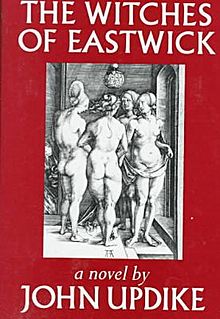 1977—Updike’s divorce being finalized, he marries Martha Bernhard on 30 September.
1977—Updike’s divorce being finalized, he marries Martha Bernhard on 30 September.
1978—The Coup is published and hailed as an energetic departure from Updike’s suburban novels.
1979—Too Far to Go: The Maples Stories is published and produced for television as an NBC two-hour movie.
1981—Updike is awarded the Edward MacDowell Medal for literature and is featured in a BBC documentary. Rabbit Is Rich is published and receives a National Book Critics Circle Award for Fiction.
1982—Updike wins the Pulitzer Prize for Fiction and the American Book Award for Rabbit Is Rich. Bech Is Back is also published.
 1983—Updike receives the Distinguished Pennsylvania Artist Award from Governor Thornburgh.
1983—Updike receives the Distinguished Pennsylvania Artist Award from Governor Thornburgh.
1984—Updike is awarded the National Arts Club Medal of Honor and Hugging the Shore receives the National Book Critics Circle Award for Criticism. The Witches of Eastwick is published.
1986—Roger’s Version, Updike’s second installment of his so-called Scarlet Letter trilogy is published.
1987—The Witches of Eastwick is made into a move featuring an all-star cast.
1988—Updike publishes S., which completes his Scarlet Letter trilogy. In October, he gives the first annual PEN/Malamud Memorial Reading at the Folger Shakespeare Library in Washington, D.C.
 1989—Updike receives the National Medal of Arts from President George H.W. Bush in a White House ceremony.
1989—Updike receives the National Medal of Arts from President George H.W. Bush in a White House ceremony.
1990—Rabbit at Rest is published.
1991—Updike wins the Pulitzer Prize for Rabbit at Rest, making him only the third American to win the Pulitzer Prize for Fiction twice. “A Sandstone Farmhouse” is awarded the First O. Henry Prize, Updike’s second.
1993—Updike’s 40th book with Knopf is published: Collected Poems, 1953-1993. In July he travels to Key West to accept the second Conch Republic Prize for Literature.
 1994—Updike’s novel Brazil is published, as is The Afterlife and Other Stories. “The Disposable Rocket” is included in Best American Essays 1994.
1994—Updike’s novel Brazil is published, as is The Afterlife and Other Stories. “The Disposable Rocket” is included in Best American Essays 1994.
1995—Updike is awarded the French rank of Commandeur de l’Ordre des Arts et des Lettres.
1996—In the Beauty of the Lilies is published, as well as the non-fiction volume Golf Dreams.
1997—Updike’s futuristic novel Toward the End of Time is published. He also receives the Campion Award.
1998—Bech at Bay is published.
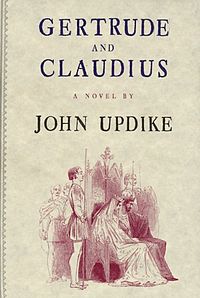 1999—More Matter is published.
1999—More Matter is published.
2000—Updike’s “prequel” to Shakespeare’s Hamlet is published: Gertrude and Claudius.
2001—Licks of Love is published, which includes the novella “Rabbit Remembered.”
2002—Americana and Other Poems is published.
2003—The novel Seek My Face is published, and Updike returns to the White House to receive the National Humanities Medal from President George W. Bush.
2004—Knopf releases John Updike: The Early Stories, 1953-1975 and Villages. “The Walk with Elizanne” is included in the Best American Short Stories 2004 volume.
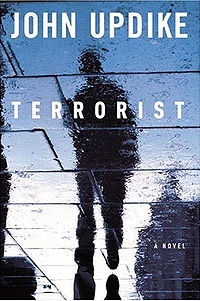 2005—Still Looking, the follow-up to his first collection of art essays, is published.
2005—Still Looking, the follow-up to his first collection of art essays, is published.
2006—Updike’s topical novel Terrorist is published, inspired by his witnessing the 9/11 attacks from a New York high-rise.
2007—Updike’s non-fiction volume Due Considerations is published.
2008—The Widows of Eastwick is published, sequel to the popular novel The Witches of Eastwick. “Extreme Dinosaurs” is included in the Best American Essays 2008.
2009—Endpoint and Other Poems, My Father’s Tears, and The Maples Stories are published. Updike dies on January 27 of lung cancer, and The John Updike Society is formed in May 2009 at the American Literature Association conference in Boston.



